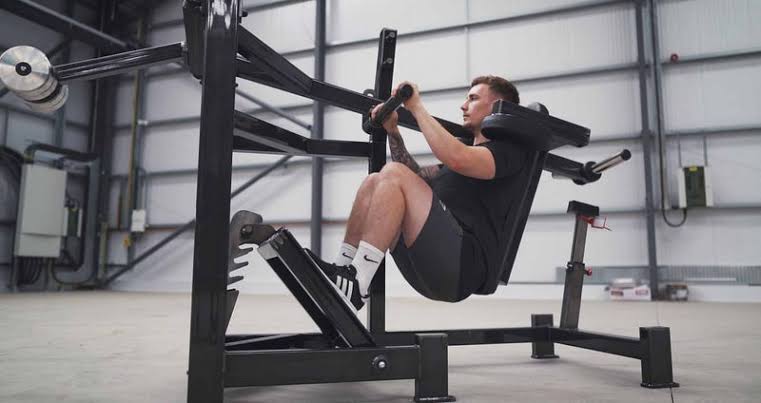Pendulum Squat: The Ultimate Lower-Body Exercise for Strength and Muscle Growth

The pendulum squat is a powerful lower-body exercise that provides an excellent alternative to traditional squats, offering benefits for strength building, muscle hypertrophy, and joint safety. This machine-assisted exercise is particularly advantageous for those looking to target the quadriceps, glutes, and hamstrings while minimizing strain on the lower back and knees. If you’re searching for an effective way to enhance your leg day routine or overcome limitations posed by free-weight squats, the pendulum squat is the perfect solution.
In this article, we’ll explore everything you need to know about the pendulum squat, including its benefits, how to perform it correctly, and how to incorporate it into your workout routine. Using a semantic SEO approach, we’ll cover related topics like variations, safety tips, and comparisons to traditional squats.
What is a Pendulum Squat?
The pendulum squat is a machine-based exercise that uses a weighted lever system to guide the body through a controlled squatting motion. Unlike traditional barbell squats that rely heavily on balance and stabilization, the pendulum squat machine ensures a fixed path of movement, allowing you to focus on muscle engagement.
Benefits of the Pendulum Squat
1. Enhanced Muscle Activation
The pendulum squat isolates the quadriceps and glutes while also engaging the hamstrings and calves. Its guided motion ensures consistent muscle activation throughout the movement.
2. Joint-Friendly Design
The machine minimizes stress on the lower back and knees, making it an ideal option for individuals recovering from injuries or those with joint issues.
3. Improved Form and Stability
The pendulum squat’s fixed motion reduces the risk of poor form, ensuring safe and effective training for beginners and advanced lifters alike.
4. Progressive Overload
With adjustable resistance, the pendulum squat allows for controlled progression, which is essential for building strength and muscle mass over time.
5. Versatility
By adjusting your foot placement and range of motion, you can target different muscle groups and achieve a well-rounded lower-body workout.
How to Perform the Pendulum Squat Correctly
Follow these steps to perform the pendulum squat with proper form:
1. Setup
- Adjust the machine’s weight to a level that challenges you without compromising your form.
- Position yourself on the machine with your back against the padded support and shoulders securely under the lever pads.
- Place your feet on the platform in a stance that suits your goals:
- Narrow Stance: Emphasizes the quadriceps.
- Wide Stance: Targets the glutes and inner thighs.
2. Execution
- Unlock the machine’s safety mechanism.
- Lower your body by bending your knees and hips, keeping your back pressed firmly against the support pad.
- Descend until your thighs are parallel to the platform or slightly lower, depending on your flexibility and goals.
- Push through your heels to return to the starting position, maintaining a controlled tempo throughout.
3. Breathing Technique
- Inhale as you lower your body.
- Exhale as you push back to the starting position.
4. Focus on Form
- Keep your core engaged to maintain stability.
- Avoid locking your knees at the top of the movement to keep tension on the muscles.
Pendulum Squat vs. Traditional Squat
| Feature | Pendulum Squat | Traditional Squat |
|---|---|---|
| Equipment | Machine-based | Free weights or bodyweight |
| Joint Stress | Reduced | Higher, especially on knees/back |
| Stability | Guided movement | Requires balance and coordination |
| Muscle Activation | Isolated and controlled | Broader engagement of stabilizers |
| Learning Curve | Beginner-friendly | Requires technique mastery |
Common Mistakes to Avoid
- Shallow Squatting
- Descending too shallow limits muscle engagement. Aim for full depth based on your flexibility.
- Poor Foot Placement
- Incorrect placement can lead to uneven weight distribution. Adjust to align with your goals and comfort.
- Relying on Momentum
- Focus on controlled movements to maximize muscle activation and minimize injury risk.
- Neglecting Core Engagement
- A tight core provides stability and protects your spine during the exercise.
Pendulum Squat Variations
1. Single-Leg Pendulum Squat
- Perform the exercise one leg at a time to correct muscle imbalances and improve unilateral strength.
2. Banded Pendulum Squat
- Add resistance bands to increase tension at the top of the movement, enhancing muscle engagement.
3. Tempo Squats
- Slow down the lowering phase and explode upwards to build strength and control.
4. Narrow Stance Squats
- Place your feet closer together to isolate the quadriceps more effectively.
5. Wide Stance Squats
- Use a wider stance to shift the emphasis to the glutes and inner thighs.
Who Can Benefit from the Pendulum Squat?
- Beginners: The guided motion helps new lifters learn proper squatting mechanics.
- Athletes: Build explosive lower-body strength for improved performance.
- Rehabilitation Patients: Safe for those recovering from injuries or dealing with joint pain.
- Bodybuilders: Isolate specific muscles for hypertrophy and definition.
Tips for Maximizing Results
- Start Light: Focus on mastering the form before increasing the weight.
- Track Progress: Keep a workout log to monitor improvements in weight, reps, and sets.
- Combine with Other Exercises: Pair the pendulum squat with lunges, leg presses, or Romanian deadlifts for a complete leg workout.
- Incorporate Variations: Use different stances and techniques to target various muscle groups.
- Rest and Recovery: Allow sufficient time for recovery to avoid overtraining and maximize gains.
Safety Considerations
- Warm-Up: Prepare your muscles with dynamic stretches and light cardio to prevent injury.
- Use Appropriate Weight: Avoid overloading the machine to maintain proper form.
- Consult a Trainer: If you’re new to the pendulum squat, seek guidance from a fitness professional.
Pendulum Squat for Weight Loss
While primarily a strength-building exercise, the pendulum squat can aid in weight loss by boosting muscle mass, which increases your resting metabolic rate. Incorporate it into a high-intensity interval training (HIIT) routine for maximum calorie burn.
Where to Find Pendulum Squat Machines
Pendulum squat machines are available at most commercial gyms. For home gym setups, fitness equipment retailers like Rogue Fitness, Cybex, and Hammer Strength offer high-quality options.
Conclusion: Why the Pendulum Squat Deserves a Place in Your Routine
The pendulum squat is an exceptional exercise for building lower-body strength, enhancing muscle definition, and protecting your joints. Its versatility and safety make it suitable for lifters of all experience levels, from beginners to advanced athletes.
By incorporating the pendulum squat into your routine, you can achieve consistent progress toward your fitness goals while minimizing injury risk. Whether you’re training for strength, aesthetics, or overall fitness, this machine-assisted squat variation is a valuable addition to any workout program.





